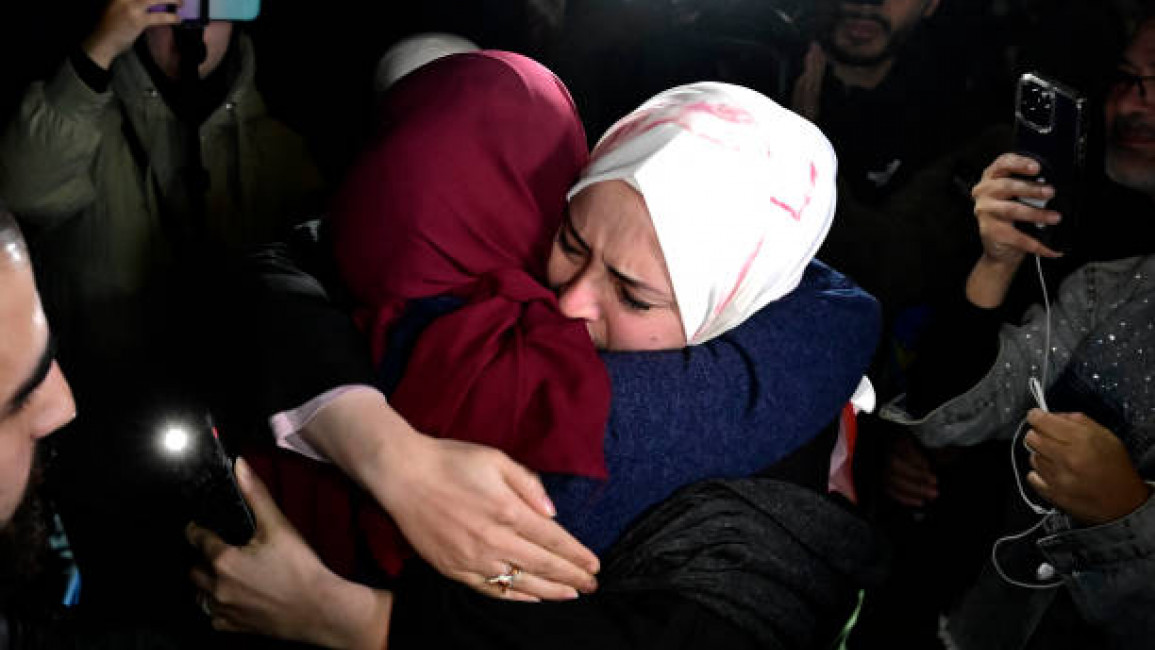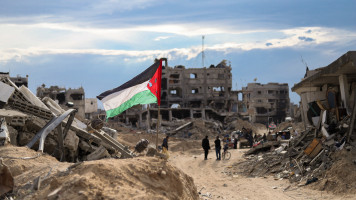The unfolding battle behind and beyond the prisoner exchange between Hamas and Israel
As the Hamas-Israel truce enters its seventh day, attention is centred on the prisoner exchange between Israel and the Palestinian group. Already, 150 Palestinians have been released, all women and minors under the age of 18 at the time of their arrest. In exchange, Hamas has released 81 hostages, including 19 citizens of Asian countries, who worked in areas around Gaza when captured on 7 October.
As about a third of Palestinians in the occupied West Bank and Gaza have been through Israeli jails since 1967, captivity by Israel has become part of Palestinians' life under occupation, developing its own ceremonies over the decades. Traditionally, Palestinian families of released prisoners receive congratulations at their house, offer sweets and sometimes dance to Palestinian music, which Israeli authorities have strictly banned since 7 October.
Israel's security minister, Itamar Ben-Gvir, ordered an "iron fist" ban on Palestinian celebrations in Jerusalem, according to Israeli media reports last week, calling celebrations "equivalent to backing terrorism".
At his orders, Israeli police went as far as confiscating sweets that families were offering visitors and neighbours.
The part of these videos that’s incredible to see is how Palestinians, despite having experienced the worst slaughter in decades at the hands of Israel, still celebrate the release of the primarily Israeli hostages. These are the people called “human animals”. https://t.co/jWxbDsi1xn pic.twitter.com/umichGSg27
— Sana Saeed (@SanaSaeed) November 26, 2023
The tension surrounding the ongoing prisoner exchange is rooted in more than the present conditions of Israel's war on Gaza or in Hamas's 7 October attacks. Far from being the first time that Palestinians and Israel exchanged prisoners, there are heavy political implications with historical background to every detail of the exchange that both sides are familiar with.
Palestinian-Israeli prisoner exchanges began in 1969 when a PFLP commando led by Leila Khaled hijacked an Israeli El-Al civilian airliner. The PFLP later released the 12 Israeli passengers and the 10 crew members in exchange for Israel's release of 37 Palestinian captives. Until the mid-1970s, two more Palestinian-Israeli prisoner exchanges took place, involving a small number of Palestinian captives released and negotiated in a short time.
In 1979, the first large-scale prisoner exchange between Israel and Palestinians took place. It was the first time an exchange carried so much political significance in every detail of the process. The deal dubbed operation 'Al-Nawras', Arabic for "The Seagle", included the release of 76 Palestinian captives, including 12 women. In exchange, the PFLP-GC released an Israeli army officer captured in an ambush the previous year.
Footage from the handover by the fighters of Al-Qassam Brigades and Saraya Al-Quds of the sixth batch of zionist detainees in the Gaza Strip as part of the humanitarian truce and the prisoner exchange.
— The Palestine Chronicle (@PalestineChron) November 30, 2023
FOLLOW OUR LIVE BLOG:https://t.co/6wdv30ilmV pic.twitter.com/YQ57M0AZay
Among the released were members of Palestinian armed cells in the occupied West Bank and Gaza, who had been convicted for armed actions that resulted in the killing of Israelis. Some had been severely tortured, all sentenced to life, including the famous US deportee Rasmea Odeh.
The fact that the exchange came at a time when Israel was entrenching mass detention as a strategy in the occupied territories, the high profile of the released, their high number in comparison to the single Israeli prisoner, and the toughness of the one-year-long negotiations, all made Israel sensitive to prisoner exchanges. On the Palestinian side, "the Seagle exchange" was celebrated as a victory.
According to post-colonial studies teacher and Palestinian writer and thinker Khaled Odetallah, "Detention is the main tool of Israeli control over Palestinian life, and that is exactly what an exchange deal challenges".
Palestinian women and children, released in the sixth batch of the prisoner exchange agreement between the Palestinian resistance and Israel, have arrived in Ramallah, West Bank. pic.twitter.com/0IDkZBQtFC
— Palestine Highlights (@PalHighlight) November 30, 2023
"Through detention, the occupation tries to impose its notion of time on Palestinians, forcing families and individuals to live through a different time clock, rhythmed by detention orders, visit permits, and shifting between in and out of jail", points out Odetallah.
In his 2005 essay written in an Israeli prison, titled "The parallel time", Palestinian prisoner, writer and thinker Walid Daqqa makes a distinction between the 'social time' lived by people outside of prison and the 'parallel time' lived by prisoners in jail, where days, months and years have a different speed, measured by the jailer's control of life. However, Daqqa also describes how the 'parallel time' imposes itself on the prisoner's family and community.
For Daqqa, writing is a form of regaining control of his life in prison and resisting the occupation's control mechanisms. According to Odetallah, "The entire mechanism crumbles at the moment of the release, as for Palestinians, prisoners and families alike, it's a break out of the occupier's ''parallel' time".
Walid Daqqa,a 61-year-old Palestinian writer, activist, intellectual, and political prisoner, was diagnosed with a rare form of bone marrow cancer in 2022. Walid has been in dire need of urgent medical attention since then. #انقذوا_وليد_الدقة#Free_Walid_Daqqah #IsraeliTerrorism pic.twitter.com/u0pJPTtHyg
— #SaveMasaferYatta (@Bayaann48) June 7, 2023
But beyond psychological dimensions, prisoner exchange deals in the Palestinian context have direct political implications. Khaled Odetallah describes this impact as "a revitalisation of the Palestinian struggle".
In 1985, after two years of negotiations, Israel reached a deal with the PFLP-GC to release three Israeli soldiers whom the group had captured in the south of Lebanon. Dubbed "Operation Galilee'', the agreement included the release of 1,155 Palestinian and other Arab nationalities'' captives, practically emptying Israeli prisons.
These included some of the most prominent Palestinian leaders in the following years, like the senior Fatah member, Hisham Abdel Razeq, who later served as minister in the Palestinian Authority, and Hamas's founder and spiritual leader, Sheikh Ahmed Yaseen.
Fearing his activities, Israel arrested Sh. Yasin and put him in jail in 1984. A year later, Israel and Popular Front for Liberation of Palestine ( PFLP- GC) reached a prisoner exchange deal (Jibril Agreement) which guaranteed his release. #AlAqsaUnderAttack pic.twitter.com/L3VKVVJQ4z
— Abdur Rehman (@AR_Dakhil) May 12, 2021
They and many others who were released in the ''Galilee'' exchange played a vital role during the first Palestinian uprising against Israeli occupation, the first Intifada, which broke out In the occupied territories only a year and a half after the exchange deal.
Israeli commentators are noticing the same effect during the current events, as several analysts on Israeli media platforms have pointed out, in the past weeks, that Hamas's' leader in Gaza, Yahya Sinwar, was himself released in the prisoner exchange between the group and Israel in 2011.
At the time, Israel released 1,027 Palestinians, including Sinwar, in exchange for Hamas's' release of Israeli soldier Gilad Shalit, captured by the group near the Gaza border fence in 2006. Israel considers Sinwar one of the masterminds of the 7 October attack and the current truce negotiations.
The Israelis began attacking the soldier Gilad Shalit who was released after 6 years in prison in prisoners exchange with Gaza in 2012, Now they are attacking him and asking him to lie & because he did not speak, looking for his support for the army in the genocide against the… pic.twitter.com/RS8cQhez0p
— Walid Mahmoud (@WalidMahmodRouk) November 27, 2023
Although all the Palestinians released so far are minors and women, Hamas continues to hold Israeli military captives in Gaza, including officers, according to the group's statements. In exchange, the deals are expected to include the release of Palestinian leaders who could significantly impact Palestinian politics, like Fatah's most popular figure, Marwan Barghouthi, and the PFLP's' secretary general, Ahmed Saadat.
"For all of these reasons, Israel finds it much less hurtful to lose soldiers in battle than to have to exchange prisoners and release Palestinians from its jails", says Khaled Odetallah. "This is why Israel put in place the so-called 'Hannibal directive"', he notes.
The ''Hannibal'' directive, or military protocol, named after the Cartegenian leader who chose to commit suicide rather than be taken prisoner by the Romans, was designed following the ''Galilee'' exchange in 1985, although it was introduced into effect in the early 1990s. It stipulates that in case of identifying a situation where an Israeli soldier is being captured by the enemy, Israeli forces would target and kill the captor and the captive alike.
Speaking with Haaretz, Israeli reserve pilot Col. Nof Erez describes Israeli army's response to Oct. 7 as "MASS HANNIBAL."
— CtrlAltDelete (@TakingoutTrash7) November 26, 2023
The Hannibal Directive orders the army to kill their own to prevent them being taken captive…@maxigan you seen this ? pic.twitter.com/9mDlOJrzh8
The Hannibal directive has been confirmed to be implemented during the 2014 Israeli war on Gaza to prevent the taking of prisoners by Palestinian fighters in the Gaza surroundings.
It has been speculated that Israel tried or successfully implemented the Hannibal directive to prevent the capture of soldiers Hadar Golden and Shaul Aron during Israel's' ground invasion of Gaza in 2014. Israel officially declared Golden and Aron dead and refused to reach a deal with Hamas for their release.
However, the large number of Israeli hostages taken on 7 October, under the collapse of the Israeli military positions in the area, including by Palestinian civilians, made it impossible for Israel to use ''Hannibal''. The military protocol was rendered ineffective.
In this atmosphere, Palestinian families try to celebrate the return of their loved ones from Israeli occupation jails. In contrast, Israeli police in Jerusalem try to ban their expression of joy, following political instructions.
"Israeli authorities'' chasing around sweets to ban the celebration of the Palestinian prisoners isn't' necessarily a sign of political calculus," says Khaled Odetallah. "Israel doesn't always behave on the basis of rational calculations, but sometimes, like now, the occupation policies are mere primitive vengeance", he adds.
However, there is a political significance to both celebrations and their banning by Israel. For Israel's Prime Minister Netanyahu, coming to terms with a prisoner exchange deal might increase the difficulty of his position in Israeli politics.
For his security minister, Itamar Ben-Gvir, it's a personal failure. Ben-Gvir campaigned his way into office on promises to worsen Palestinian prisoners' jail conditions and championed the death penalty for Palestinian prisoners.
In 2018, Ben-Gvir filmed himself going into a Red Cross bus, carrying families of Palestinian prisoners on their way to visit them, and verbally assaulting them with slurs and threats. Since he took office as minister, Ben-Gvir has been waging a series of measures to worsen jail conditions for Palestinians, even clashing with the Israeli prison services for provoking protests by Palestinian prisoners, for almost a year before 7 October.
Beyond the direct, physical outcome of the exchange deals, the release of Israeli hostages and dozens of Palestinian prisoners, the exchange, and the ones potentially to come, have political, social and psychological impacts. An impact that will undoubtedly stretch far beyond the current war and the current Israeli government and influence the shape of the conflict for years to come.



